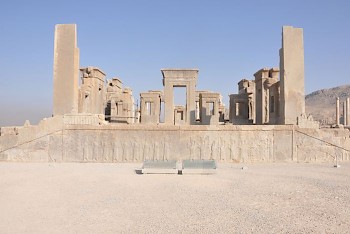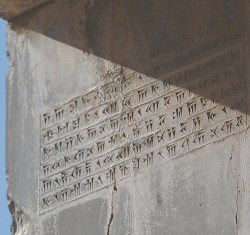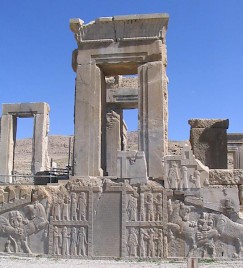Persepolis, Palace of Darius
Q6564498Persepolis (Old Persian Pârsa, modern Takht-e Jamshid): Greek name of one of the capitals of the ancient Achaemenid Empire, founded by king Darius the Great (r.522-486 BCE). There were several satellite sites, Naqš-e Rustam and Takht-e Rustam.

The palace known as Taçara, "winter palace", in Persepolis (#3 on the map) was, according to the inscription known as DPa, built by king Darius I the Great. However, the great king did not live to see it finished. It was completed after his death in 486 by his son and successor Xerxes, as we can read in an inscription he left behind (XPc). Its ruins are immediately south of the Apadana. Compared to Xerxes' Palace, the Apadana and the Treasury, the Taçara has remained well-preserved. The big stone structures have survived; only the parts of wood have vanished.

This strongly suggests that the Palace of Darius was spared when the Macedonian king Alexander the Great destroyed Persepolis in 330. His men were especially interested in the palace of the man who had once sacked Athens, and in the two two buildings that symbolized the Persian redistribution economy. Darius was, in European eyes, not a criminal.
There were several building inscriptions, like the one near the doors, known as DPa. It says: "Darius, the great king, king of kings, king of countries, Hystaspes' son, an Achaemenid, built this palace".

The sculptors who cut the reliefs of the Palace of Darius used, for the first time, motifs that were to become very popular in later Achaemenid art. For example, you can see the king entering the building, attended by servants with a fan. This type of decoration can also be found in the Palace of Xerxes, the Hall of a Hundred Columns, the Tripylon, and the Queen's Quarters. (It is remarkable that the same motif was used in public and private space.)
Another motif is the royal warrior, who kills a lion, a winged bull, or another wild beast. The stairs were decorated with small people who were bringing animals and ingredients upstairs, a motif that was repeated in other buildings.
An interesting innovation can be found on the lintels. They are made in an Egyptianizing style, which inspired later generations. The same type of decoration was used, more than seven centuries later, in the palace of the Sasanian king Ardašir I (r.224-241 CE) in Firuzabad.

In the third quarter of the fourth century, more than a century after the palace had been completed, Artaxerxes III Ochus added a western gate with a staircase, an added inscription known as A3Pa, which can also be found on several buildings in the neighborhood. There must have been a garden near this new western entrance: one of the small canals is still visible, and it is perhaps not too far-fetched to assume that the great king could sit down over here, enjoying the view of the western plain.
The rooms were of course beautifully decorated. Even the window cornices and doorknobs were inscribed (DPc, DPi).















